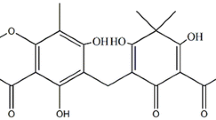Summary
Comedonal bacteria, Propionibacterium acnes, P. granulosum and coagulase-negative staphylococci (CNS) seem to play an important initiating role in the inflammatory process by producing neutrophil chemotactic factors. The attracted neutrophils, after phagocytosis, release inflammatory factors such as reactive oxygen species (ROS). We investigated the effects of minocycline at subminimal inhibitory concentrations (sub-MIC), i.e. one-tenth MIC, on the production of human neutrophil chemotactic factors in comedonal bacteria, and on several inflammatory parameters of neutrophils, including neutrophil phagocytosis and generation of ROS (O −2 , H2O2, O\({\text{H}}^{\text{.}} \)). ROS generation in a cell-free, xanthinexanthine oxidase system was also assessed. Production of neutrophil chemotactic factors in all strains of P. acnes, P. granulosum and CNS were significantly suppressed by sub-MIC minocycline. Sub-MIC minocycline effectively reduced three kinds of neutrophil-generated ROS (O −2 , H2O2, O\({\text{H}}^{\text{.}} \)). However, neutrophil phagocytosis and the ROS generated in a cell-free system were not markedly changed in the presence of sub-MIC minocycline. The results suggest that sub-MIC minocycline has an anti-inflammatory effect by inhibiting the production of neutrophil chemotactic factors in comedonal bacteria as well as ROS generated by neutrophils in the inflammatory process of acne.
Similar content being viewed by others
References
Akamatsu H, Komura J, Miyachi Y, Asada Y, Niwa Y (1990) Suppressive effect of linoleic acid on neutrophil oxygen metabolism and phagocytosis. J Invest Dermatol 95:271–274
Baird-Parker AC (1974) Staphylococcus. In: Buchanan RE, Gibbons NE (eds) Bergey's manual of determinative bacteriology, 8th edn. Williams & Wilkins, Baltimore, pp 483–489
Bligh EG, Dyer WJ (1959) A rapid method of total lipid extraction and purification. Can J Biochem Physiol 37:911–917
Boyden S (1962) The chemotactic effect of mixtures of antibody and antigen on polymorphonuclear leukocyte. J Exp Med 115:453–466
Esterly NB, Furey NL, Flanagan LG (1978) The effect of antimicrobial agents on leukocyte chemotaxis. J Invest Dermatol 70:51–55
Esterly NB, Koransky JS, Furey NL, Trevisan M (1984) Neutrophil chemotaxis in patients with acne receiving tetracycline therapy. Arch Dermatol 120:1308–1313
Forsgren A, Schmeling D (1977) Effect of antibiotics on chemotaxis of human leukocytes. Antimicrob Agents Chemother 11:580–584
Goto S, Kawakita T, Kozaki N, Mitsuhashi S, Nishino T, Osawa N, Tanami H (1981) Methods for determination of minimum inhibitory concentration (MIC). Chemotherapy 29:76–79
Johnson AR, Erdos G (1977) Metabolism of vasoactive peptides by human endothelial cells in culture. J Clin Invest 59:684–695
Johnston RB Jr, Lehmeyer JE (1976) Elaboration of toxic oxygen by-products by neutrophils as a model of immune complex disease. J Clin Invest 57:836–841
Kishishita M, Ushijima T, Ozaki Y, Ito Y (1980) New medium for isolating Propionibacteria and its application to assay of normal flora of human facial skin. Appl Environ Microbiol 40:1100–1105
Klebanoff SJ, Rosen H (1978) Ethylene formation by polymorphonuclear leukocytes. J Exp Med 148:490–505
Knutson DD (1974) Ultrastructural observations in acne vulgaris: the normal sebaceous follicle and acne lesions. J Invest Dermatol 62:288–307
Kosakai N, Ueno K, Goto S, Mihashi S, Nakayama K, Shimada K, Tamaki K, Oguri T (1972) Agar dilution procedure for antimicrobial susceptibility testing of anaerobic bacteria. Chemotherapy 27:559–561
Marples RR, McGinley KJ, Mills OH Jr (1973) Microbiology of comedones in acne vulgaris. J Invest Dermatol 66:80–83
Martin RR, Warr GA, Couch RB, Yeager H, Knight V (1974) Effects of tetracycline on leukotaxis. J Infect Dis 129:110–116
Massey V (1959) The microestimation of succinate and the extinction coefficient of cytochrome c. Biochim Biophys Acta 34:255–256
Miyachi Y, Yoshioka A, Imamura S, Niwa Y (1986) Effect of antibiotics on the generation of reactive oxygen species. J Invest Dermatol 86:449–453
Niwa Y, Sakane T, Shingu M, Yanagida I, Komura J, Miyachi Y (1985) Neutrophil-generated active oxygens in linear IgA bullous dermatosis. Arch Dermatol 121:73–78
Niwa Y, Kasama T, Miyachi Y, Kanoh T (1989) Neutrophil chemotaxis, phagocytosis and parameters of reactive oxygen species in human aging:cross-sectional and longitudinal studies. Life Sci 44:1655–1664
Root RK, Metcalf JA (1972) H2O2 release from human granulocytes during phagocytosis. J Clin Invest 60:1266–1279
Skosey JL, Damgaard E, Chow DC, Sorensen LB (1974) Modification of zymosan-induced release of lysosomal enzymes from polymorphonuclear leukocytes by cytochalasin B. J Cell Biol 62:625–634
Stossel TP (1973) Evaluation of opsonic and leukocyte function with a spectrophotometric test in patients with infection and with phagocytic disorders. Blood 42:121–130
Webster GF, Kligman AM (1979) A method for the assay of inflammatory mediators in follicular casts. J Invest Dermatol 73:266–268
Webster GF, Leyden JJ (1982) Mechanisms of Propionibacterium acnes mediated inflammation in acne vulgaris. Semin Dermatol 1:299–304
Webster GF, Leyden JJ, Tsai CC, Baehni P, McArthur WP (1980) Polymorphonuclear leukocyte lysosomal release in response to Propionibacterium acnes in vitro and its enhancement by sera from patients with inflammatory acne. J Invest Dermatol 74:398–401
Webster GF, Leyden JJ, McGinley KJ, McArthur WP (1982) Suppression of polymorphonuclear leukocyte chemotactic factor production in Propionibacterium acnes by subminimal inhibitory concentrations of tetracycline, ampicillin, minocycline, and erythromycin. Antimicrob Agents Chemother 21:770–772
Author information
Authors and Affiliations
Rights and permissions
About this article
Cite this article
Akamatsu, H., Niwa, Y., Kurokawa, I. et al. Effects of subminimal inhibitory concentrations of minocycline on neutrophil chemotactic factor production in comedonal bacteria, neutrophil phagocytosis and oxygen metabolism. Arch Dermatol Res 283, 524–528 (1991). https://doi.org/10.1007/BF00371927
Received:
Issue Date:
DOI: https://doi.org/10.1007/BF00371927




